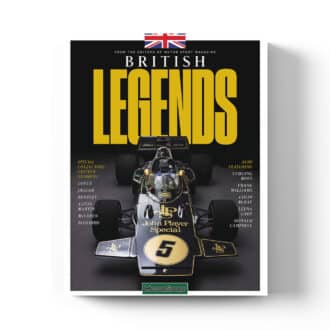
The Editor: March 2019
You will have noticed that there have been some changes to your issue of Motor Sport this month. As a reader I know that any change to a much-loved magazine…
Scroll down the grid of any major sports car race on either side of the Atlantic in the late 1980s or early ’90s, and you’ll almost certainly find multiple chassis built by Spice Engineering. The star of the Silverstone-based constructor shone brightly for a period of a few short years in which it built more than 50 prototypes.
Buoyant sales reflected success on the race track. Spice-equipped teams won the Group C2 World Championship title three years on the trot between 1987 and ’89, and again in 1992 when competitors in a revived secondary class competed for what was known as the FIA Cup. Over the Pond, there were five titles in the Camel Lights division of the IMSA GT Championship between 1989 and ’92. Six class wins at the Le Mans 24 Hours can be added to that roll of honour.
The Spice CV makes for even more impressive reading when you consider that the company came about pretty much by mishap and coincidence.
Tin-top and sports car legend Gordon Spice’s operation had been left high and dry by Ford’s decision to axe the Group C programme for which his team had built a third generation of the underachieving C100 for the 1983 season. He managed to scratch together a deal to stay afloat through ’83 and into ’84 when he was introduced to wealthy historic racer Ray Bellm, who happened to live next door to his brother.
“The aim was to make a turn-key racer in the mould of the Porsche 962”
Bellm had aspirations to race at Le Mans and after a handful of races together in a Spice-run Tiga, they formed Spice Engineering with the intent of becoming a constructor. Their aim was to produce a turn-key racer in the mould of the Porsche 956/962, aimed at C2 and Camel Lights.
The new company employed ex-Hesketh, March and Theodore designer Graham Humphrys to come up with a new car and, in the interim, update the Tiga in which Spice and Bellm claimed the World Endurance Championship C2 title in 1985. Design of the fledgling marque’s own car was well underway when Spice got wind that Pontiac was planning some kind of sports car programme. An approach resulted in the first chassis carrying a body styled after General Motors’ Fiero two-seater. The aerodynamics weren’t great, but it gave the fledgling constructor a kick start.
The quirky Spice SE86C, known in its Pontiac-powered form as the Fiero GTP in the US, was an immediate success. Spice and Bellm reprised their C2 title in what was now known as the World Sports-Prototype Championship with Cosworth DFV motivation.
That success paved the way for the first customer cars. Hugh Chamberlain bought one – it had an F1-derived Hart turbo – and a trio of customer Fieros were built for the US. By 1989 production was into double figures and company turnover in excess of £6 million, or £15 million in today’s money.
Spice made its own body for 1988 and Humphrys’ design evolved around the aluminium honeycomb monocoque. The track and wheelbase increased, along with rear suspension revisions as the world series moved into the 3.5-litre era. The end of Group C2 took away Spice’s market, and coincided with a global recession.
The company went into administration in late 1990 and limped on for a couple of years first under Japanese and then Anglo-French ownership. Spice Engineering’s legacy lived on, however. Its cars, now sans roofs, bulked out the early grids of IMSA’s World Sports Car category in 1994.
• Price new N/A
• Price now £250,000-£300,000
• Engine Cosworth DFV 3.0-3.3-litre V8, Pontiac 3.0-litre four-cylinder, etc
• Rivals Argo JM19, Ecosse C286
• Verdict One of the great customer sportscars of its era enjoyed phenomenal success in the world and North American arenas
Quite available, and still widely raced in Grp C
Historic Group C racing allows drivers to compete at some of the best circuits in the world, at similar levels of performance as F1 cars of the same era.
In 2012 SE90C chassis 08 went to auction with an estimate of €170,000 – €180,000 but achieved a high bid of only €140,000. Since then only classified adverts are able to provide indicators of the market.
There are currently a number for sale; in December 2018 chassis 16 was listed for sale at €425,000 (£390,000), chassis 11 is for sale at $325,000 (£270,000) and chassis 17 was recently listed for sale at £300,000.
The SE90C came with a choice of two variants of the DFV engine – the DFR or the DFL. Although Spice estimated the running cost of the DFR to be three or four times more, due to the extra vibrations it caused. One would hope that 30 years later these issues have been ironed out, but a full engine rebuild is still estimated at £15,000 and is needed every two years.
Market preference is for cars that have benefited from recent race preparation, rather than those which have been laid up. Chassis 17 is up for sale at the Bonhams Goodwood Revival event in September with a guide of £200,000 – £260,000.
Robert Johnson,
Classic and Sports Finance




